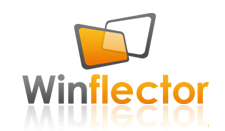Automatic client updates
Winflector software is to be used for running business applications. Consequently, it is designed to minimize administrative tasks such as updates.
Updating to a new Winflector client version is done by installing the new version of the Winflector server on the application server. The configuration data (settings, users, applications, permissions) can be used by the new installation. Winflector server is not updated automatically since in real business environments administrators prefer to have control over the update process: the exact timing of the update and its scope. Moreover, due to the security concerns application servers in such environments often do not have access to the Internet.
Installed alongside the Winflector server is a complete set of files for the Windows and Linux Winflector clients. Actual installation of new client version is done whenever a Winflector client connects to the server to start an application. If the client program determines that there is a new server version running, automatically downloads the complete set of files of the new client version and starts the application. Due to the small size of client files the update process runs fast even on a wide area network. All shortcuts on the client station pointing to the wfc.exe program remain unchanged. This update mode has the following advantage:
- It completely eliminates manual installation of updates on terminal stations.
- The update process is entirely transparent to the user. Only a short information and a progress indicator appears shortly before the shared application is started.
- Access to the Internet or to any update servers of third parties is not required.
- The update is processed through the same communication channel which is used for remote application access, thus no additional configuration of network devices is required to allow access to an update server.
- Workstations using client software installed on a shared network drive do not download upgrade files concurrently. Only the first workstation downloads files, while the remaining wait for download to be completed. This reduces the traffic in a backbone network
- The update procedure can be used to automatically distribute additional user files (e.g. client dedicated DLL extensions containing RPC functions, configuration files, etc.)

